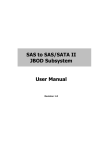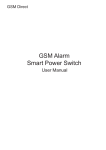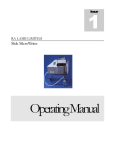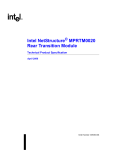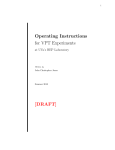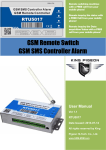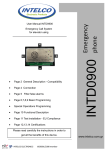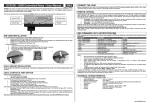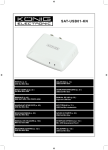Download Technical Specifications - Photo Express GSM user manual
Transcript
3 POLUS GSM RELAY SENSOR ALARM SWITCH OPERATION MANUAL TABLE OF CONTENTS 1 Description and Operation 4 1.1 1.2 1.3 1.4 1.5 Function GSM Relay Sensor Alarm Switch Package Contents Technical Specifications GSM Relay Sensor Alarm Switch Structural Design Operation of the GSM Relay Sensor Alarm Switch 4 4 5 5 7 2 Set-Up 8 2.1 2.2 2.3 2.4 2.5 2.6 2.7 Preparing the GSM Relay Sensor Alarm Switch for operation Configuring the GSM Relay Sensor Alarm Switch Accessing Programing mode Setting-up for First Time Use Verifying set-up Changing & Adjusting the Parameters GSM Relay Sensor Alarm Switch Installation 8 8 10 11 11 12 13 3 Troubleshooting the POLUS GSM Relay Sensor Alarm Switch 14 4 Contact Us 14 5 Warranty 15 4 1 1.1 - 1.2 Description and Operation Function The POLUS GSM Relay Sensor Alarm Switch was designed to notify the subscriber’s mobile telephone via an SMS and a call (up to six (6) notification numbers), when triggered by a change in the position of the Relay Sensor Alarm Switch contacts (opened or closed position) caused by any externally (hard wired) connected device. Any device can be connected to the Relay Sensor Alarm Switch input contacts that permits monitoring it’s state by means of Open/ Closed contacts. The Relay Switch can also be utilized as a “Panic” button, etc. Attention: Only devices with dry contacts can be connected to the Relay Switch. The Relay Sensor Alarm Switch supports the following operational modes: Programming; “Armed On Guard”; POLUS GSM Relay Sensor Alarm Switch FEATURES: Installs at any location with mobile GSM reception; Arms and Disarms by simply turning power “ON” or “OFF”. Settings programmable via mobile telephone, online and thru utilizing “Configurator Express GSM” Android, iOS apps or the “GSM Central Control Monitoring Panel; Uses two interface languages: English and Russian; Operates on a single 3 volt CR123 lithium battery for up to 12 months; Automatically identifies remaining SIM card balance inquiry telephone number; Capable of displaying GSM signal strength with each SMS notification sent; The device was designed to operate indoors and monitor around the clock 24/7 in stable nonextreme and non-explosive conditions. Package Contents Include in accordance with Table 1. Table 1- Contents Description Quantity POLUS GSM Relay Sensor Alarm Switch- (1) one Lithium CR123A 3V battery- (1) one User's Manual- (1) one 5 1.3 Technical Specifications Table 2- Primary Technical Specifications DESCRIPTION VALUE Max. Number of telephones notified(6) six Time lapse for notification20-40 seconds GSM Module Operating StandardsGSM-800/900/1800/1900 Battery type1 x CR123A 3 V Uninterrupted operating life span using one up to 12 months battery at a temperature of +25CTemperature operating rangefrom -10 C to +50 C Enclosure durability levelIP40 93% Relative operating humidity @ +35С Condensation, not to exceedRelay Sensor Alarm Switch size & dimensions 109x32x27.5 mm do not exceedRelay Sensor Alarm Switch (w/ battery) weight 60 g does not exceed* Note: The Relay Sensor Alarm Switch is capable of operating at temperatures below -25 C, but the battery operating life will be reduced as well as the number of transmitted SMS notifications. 1.4 Relay Sensor Alarm Switch Design The Relay Sensor Alarm Switch unit consists of a cover body with a LED indicator and a base (diag. 1 & 2). Inside the cover body, mounted on the base, is the controller circuit board, to which the GSM module is attached (diag. 3). The circuit board and cover body attach to the base unit using clips. The cover body and base unit are made of ABS plastic. Diagram 1: General overview of the Relay Sensor Alarm Switch Design 6 Diagram 2: Top & bottom view of the Relay Sensor Alarm Switch Design The controller circuit board (refer to diagram 3) contains a: battery holder GB1, audio indicator BQ1, two color LED indicators VD1 and a terminal block X2 for connecting to the Relay Sensor Alarm Switch contacts. The two color LED’s indicate the state of the Relay Sensor Alarm Switch in accordance with table 3. The GSM module circuit board contains a SIM cardholder (XS3) and a “GSM” LED to indicate network signal strength. Diagram 3: Exposed view of the controller circuit board and GSM module The Relay Sensor Alarm Switch ships with an installed battery insulated from the battery contacts by a protective plastic insert (refer to diagram 5). 7 1.5 Operation of the Relay Sensor Alarm Switch 1.5.1 Primary Functions of the Relay Sensor Alarm Switch The Relay Sensor Alarm Switch executes the following functions: - Monitors and detects a change in the position of the Relay Switch contacts when connected to an external device; - Transmits SMS notifications and/ or calls the list of notification telephone numbers (up to six (6) numbers) programmed into the Relay Sensor Alarm Switch SIM card memory when triggered by a change in the position of the Relay Switch contacts; - Inquires and requests remaining Relay Switch SIM card balance and transmits it in an SMS to the primary notification telephone number; - Automatically recognizes the inquiry number required to make a remaining SIM card balance inquiry. 1.5.2 Operational modes of the Relay Sensor Alarm Switch Upon activating power (by either removing the protective plastic insert from in between the battery and contacts or by inserting a battery), the Relay Sensor Alarm Switch will discover and connect to a GSM network and then enter “Programming” mode; One (1) minute after all the settings are completed, the Relay Sensor Alarm Switch enters “Armed On Guard” mode. While in “Armed On Guard” mode and when triggered by inputvia terminal block X2 causing a change in the position of the Relay Switch contacts (Opened/ Closed), the Relay Switch will enter “ALARM” mode and will then execute notifications via SMS and/ or by placing outgoing calls. After concluding “ALARM” notifications, the Relay Sensor Alarm Switchre-enters “Armed On Guard” mode. The Relay Sensor Alarm Switch is “Disarmed” by interrupting the power source by either replacing the protective plastic battery insert or by removing the battery. 1.5.3 Relay Sensor Alarm Switch Indicators The Relay Sensor Alarm Switch has built-in LED and sound indicators. In addition, the GSM LED indicates GSM signal strength. Indicator mode descriptions can be found in Table 3. Table 3- Security Alarm Sensor Indicators Event/ Mode LED Indicator Sound Indicator Power On Glows Red ― GSM Network Search Glows Red ― GSM Network Activation (At Start-up) Programming Mode Relay Sensor Switch Incoming Call or SMS “Armed On Guard” Mode Closed Contacts Notification Open Contacts Notification Flashes Red/Green Glows Green ― 3 Beeps ― Audio Beep ― Glows Red Glows Green 8 ― ― ― GSM LED Indicator Glows Red 3 Sec. Flashes for 20-40 Sec. Once every 4sec. ― ― ― ― ― 1.5.4 Notifications The GSM Relay Sensor Alarm Switch transmits “ALARM” SMS notifications to the numbers registered at “1SMS”…”6SMS” (Diag.4). The primary number registered at “1SMS” will receive SMS notifications containing the selected settings (Item 2.4, diag. 8), Test/status SMS notifications showing remaining SIM card balance and Auto Reset to “Armed On Guard” mode (Diag. 6). Test/status SMS notifications are sent depending on the interval selected (Table 4, Cell# 14). The interval time reference point is established and starts upon the receipt of the settings notification. When an “Alarm” is triggered, the GSM Relay Sensor Alarm Switch will transmit an SMS notification, place a call to the first registered (primary) number and will then place calls to the remaining numbers together with transmitting SMS notifications (up to a total of six (6) numbers). The GSM Relay Sensor Alarm Switch will cease calling the first number and will proceed to call the next number under the following circumstances: - When the subscriber disconnects the incoming call; - When the subscriber does not respond by picking-up within 30 seconds; - When the subscriber’s line is busy; - When the subscriber is out of network; Calling out will cease after one of the subscriber numbers picks up and disconnects; then the GSM Relay Sensor Alarm Switch will transmit “Alarm” (Diag. 4) notifications to the numbers located at cell positions “2SMS”…”6SMS”. Pcn ON SNN% Pcn OFF SNN% Diagram 4: Default notification indicating the position of the Relay contacts Pcn ON- Relay contacts closed, Pcn OFF- Relay contacts open S- indicates GSM network signal strength; NN- indicates GSM network signal strength as a percentage (e.g.S50%, S75%, etc.) The value indicating network signal strength (SNN%) is included in all SMS notifications with the exception of notifications showing remaining SIM card balance. 2 Set-Up 2.1 Preparing the Relay Sensor Alarm Switch for Operation After opening the package, visually inspect the GSM Relay Sensor Alarm Switch for any physical defects and to confirm all item parts are included. Prior to operating the Switch, disable the PIN number request feature on the SIM card with the assistance of a mobile telephone (refer to mobile telephone user’s manual). Check and verify there is a sufficient balance on the SIM card. 2.2 Configuring the Relay Sensor Alarm Switch At initial power-up, the GSM Relay Sensor Alarm Switch records on to the SIM card the following parameters and values in accordance with Table 4. 9 Table 4- GSM Relay Sensor Alarm Switch Settings Cell# Cell label Default Value Description 1 1sms 000 1st telephone number (primary) for notification Enter number in the following format +1********** e.g.:+17180000000 2 3 4 5 6 2sms 3sms 4sms 5sms 6sms 000 000 000 000 000 Telephone numbers for notification Enter number in the following format +1********** e.g.:+17180000000 7 BALANS 0 Remaining balance Inquiry USSD Auto detection of remaining balance tel. number; Manual entry of tel.# e.g.: *100# Sets frequency for test/ status SMS notifications. Interval sets up to 250 days. e.g.: 1- Notification once a day 7- Notification once a week 0- Notification not sent. 0- Only SMS to 1sms...6sms 1- Call + SMS (SMS sent to1sms, then callsplaced to all tel. numbers, followed by SMS transmittal to allremaining tel.numbers @2sms... 6sms. 3- Only calls placed to 1sms...6sms Text up to 20 Latinalphabet characters, e.g.: ALARM 14 TEST 7 18 AlarmNot 1 26* Pcn ON 1 27* Pcn OFF 1 34** POLUS 1 35 Мnum 000 36 LANG 0 Available Values Frequency for test/ status SMS notifications Alarm notification Option/Type when Relay contact position Changes Event Description whenRelay Contacts Closed Event Description whenRelay Contacts Open Template name w/settings For operation w/Polus GSM Security Panel application Notification Language 0- Notification not executed 1 Relay SensorAlarmSwitch SIM Tel.# 0-Ru 1-En *- Attention!In cell’s No.26 and No.27, instead of setting (changing) the value, the cell label name should be changed. **- Operating service data that creates template during GSM Alarm Sensor Switch set-up. 10 2.3 Accessing Programing Mode In order to access “Programing” mode, consecutively execute the following actions. 1. Install the SIM card as shown in diag. 5. Caution! Prior to installing or removing the SIM card, it is necessary to de-activate the GSM Relay Sensor Alarm Switch electrical supply! (i.e. install the protective plastic battery insert or remove the battery). 2. Remove the Protective Plastic battery Insert from in between the contacts and the battery (see diag. 5) or install a battery using correct polarity (if previously removed). Diagram 5: SIM card installation and protective plastic battery insert removal 3. The GSM Relay Sensor Alarm Switch LED indicator will glow red. The “GSM” LED will glow for 3 seconds and will begin to flash quickly. 4. Wait for the SIM card to register on to the GSM network. At the conclusion of registration, 3 beeps will be heard and the “GSM” LED will flash (1) once every (4) four seconds. The GSM Relay Sensor Alarm Switch LED indicator will glow green. This indicates that the GSM Relay Sensor Alarm Switch has entered “Programing” mode. During the entire duration of the “Programing” mode, the LED indicator will glow green. In the event the “GSM” LED continues to flash quickly, (the SIM card is not registering on the GSM network) and might be due to the SIM card being incorrectly or not installed, blocked by a PIN code or the GSM network is inaccessible (take steps in accordance with table 5). Upon entering “Programing” mode, the GSM Relay Sensor Alarm Switch sends an SMS notification with settings to the primary notification telephone number (if the primary number was previously recorded in the SIM card memory). For the span of (1) one minute, the GSM Relay Sensor Alarm Switch remains in “Programing” mode and stands by for an incoming call and/ or SMS containing any changes to the settings. In the absence of an incoming call/ SMS, the GSM Relay Sensor Alarm Switch at the expiration of (1) one minute enters “Armed On Guard” mode. In the event of an incoming call/ SMS occurring and being accepted, the GSM Relay Sensor Alarm Switch at the expiration of (1) one minute, will enter “Armed On Guard” mode and will transmit an SMS notification reflecting the setting changes to the primary registered telephone number. 11 2.4 Setting-up for First Time Use After powering-up the GSM Relay Sensor Alarm Switch, a template with cells containing default values will be created in the SIM card phone book (in accordance with table 4). Later on, you are able to edit and alter these parameters and values. It is necessary to record notification telephone numbers to the SIM card memory. Perform the followings steps consecutively. 1. Access “Programing” mode in the device (see item 2.3). 2. Begin by calling the GSM Relay Sensor Alarm Switch SIM card telephone number from the telephone number that will be used as the primary notification number. After receiving and recording the number, the GSM Relay Sensor Alarm Switch will disconnect the call and emit (1) one audible confirmation beep. This number will be recorded in cell# 1 “1SMS” (see table 4) as the designated primary number and will send an SMS notification from the GSM Relay Sensor Alarm Switch indicating “Setting Reset, Number Added +1xxxxxxxxxx”. 3. Proceed to record any additional notification telephone numbers by calling from each of them and after each additional number is recorded, an SMS notification is sent to the primary telephone number containing “Number Added+1zzzzzzzzzz”, “Number Added+1zzzzzzzzzz” etc. 4. One (1) minute after the last call is received, the GSM Relay Sensor Alarm Switch will transmit an SMS containing the settings (see diag. 8) to the primary telephone number and will then enter “Armed On Guard” mode. If you were unable to record all the necessary additional notification telephone numbers, either re-insert in the Protective Plastic Insert between the battery and contacts or remove the battery, wait (2) two minutes and then repeat the procedure from the beginning- see item 2.6. 1) Primary notification number 14) Frequency of test/status notifications Received from +1YYYYYYYYYY 18) Notification option/type 1)+1XXXXXXXXXX,7)*100#, 14)7,18)1,26)Pcn ON, 27)Pcn OFF,36)1,SNN% 26) Relay Pcn Contacts Closed GSM Relay Sensor Alarm Switch number 7) Balance Inquiry 27) Relay Pcn Contacts Open 36) Notification language Signal Strength Diag.6- Sample SMS with Settings 2.5 Verifying Set-up 1. While in “Armed On Guard” mode, close the contacts on terminal block X2 using a snippet of wire, tweezers or a paper clip, etc.. 2. The Relay Switch LED indicator will glow Red; the Relay Sensor Alarm Switch has recognized a change in the position of the contacts (from “Open” to “Closed”) and will commence Notifications 3. Wait to receive an SMS notification containing the text “Pcn ON” and an incoming telephone call from the Relay Switch (acknowledge by disconnecting the incoming call). 4. After the concluding the notifications, the LED indicator will turn off and the Relay Sensor Alarm Switch will re-enter “Armed On Guard” mode. 12 5. Open the contacts onterminal block X2. The events will be analogical to previous pt.’s 2-4, but the position of the contacts will have changed from “Closed” to “Open”, the Relay Switch LED indicator will glow green andthe SMS notification will contain the text “Pcn OFF”. 2.6 Changing the Parameter Value Settings Value parameter settings are installed during the (1st) first power-up and can later be changed. The parameter values can be changed using the following methods. Method-1 The GSM Relay Sensor Alarm Switch settings can be configured by using the “Online Service” located at service.alpha-safe.com, by utilizing the “Express GSM Configurator” for Android or iOS or by using the application for central monitoring “GSM Panel” available for download from play.google.com (search: “Express GSM” or “GSM Panel”). The created configuration will be sent to the GSM Relay Sensor Alarm Switch SIM card. Method-2 1. Using the primary notification telephone, create an SMS message using values in accordance with table 4. For example, in order to change the notification method, it is necessary to send an SMS message containing the following text: “18)0”; where 18) indicates the cell number and 0 indicates the selected parameter value. Note: Characters are entered without quote marks and spaces. In order to change several parameters at once, it is necessary to list the parameters separating them with a comma. For example: “2)+1xxxxxxxxxx,18)3,27)Alarm,36)1” etc. Note: Characters are entered without quote marks and spaces. 2. Access “Programing” mode in the GSM Relay Sensor Alarm Switch (item 2.3). 3. Send a previously prepared SMS message to the GSM Relay Sensor Alarm Switch telephone (SIM card) number. 4. Wait to receive an SMS notification confirming the selected parameter values. Method-3 It is possible to change and configure the parameter values directly with the aid of a GSM mobile telephone. In order to accomplish this, install the GSM Relay Sensor Alarm Switch SIM card into any GSM mobile telephone. To access the necessary parameter, open the telephone book, select the cell to be altered and make the necessary changes in accordance with table 4. For example, in order to change the primary notification telephone number, in the telephone book select “1SMS”, then select “change”, erase the old number and record the new primary notification telephone number, etc. Note: Some mobile telephone models do not support this function. Attention! In cell’s No.26 and No.27, (Pcn ON and Pcn OFF), instead of setting (changing) the value, the cell label name should be changed. In addition to the change parameter methods listed above, adding/ deleting notification telephone numbers can also be accomplished via a telephone call from the primary notification 13 telephone number to the GSM Relay Sensor Alarm Switch while in “Programing” mode. After calling from the primary notification telephone number, all telephone numbers contained in the SIM card memory are erased and it will be necessary to re-add all required telephone numbers all over again. Attention! This action resets all settings to the default settings (as shown in Table 4). 2.7 Relay Sensor Alarm Switch Installation The Relay Sensor Alarm Switch should be installed at a location that will be shielded from atmospheric elements, physical damage and access by unauthorized persons and will have access to a reliable GSM signal. The Relay Sensor Alarm Switch should be located away from high power electrical cables. Diag. 7- Installation Size Specifications In order to install the GSM Relay Sensor Alarm Switch, consecutively execute the following steps: 1. Select a location to install the GSM Relay Sensor Alarm Switch. 2. Mark-up the selected installation location bearing in mind measurements and the location of mounting holes as located on the GSM Relay Sensor Alarm Switch base. 3. Install the GSM Relay Sensor Alarm Switch by removing the cover and the circuit board from the base. Run and connect wires to terminal block X2 (having previously breaking-out the plastic plugs from the input openings) and attach the base using two screws, then snap-in the circuit board and then replace the cover. Double-sided tape can also be used to mount the GSM Relay Sensor Alarm Switch on to a properly prepared surface. 4. Verify operation in accordance with item 2.5. 5. Fasten the connection wires and attach them to the intended device. 14 3 Troubleshooting the GSM Relay Sensor Alarm Switch Table 5- Troubleshooting Guide Description of Symptom No “GSM”LED flashes in the GSM RelaySensor Alarm Switch after the Battery is installed. After powering up the GSMRelay Sensor Alarm Switch(inserting the battery) the “GSM”LED flashes rapidly& does not flash once (1)Every (4) four seconds asRequired (SIM card is not Logging on to the network) When verifying operation, theGSM Relay Sensor Alarm SwitchDoes not recognize a change in the position of the Relay Sensor Alarm Switch contacts (from open to Closed): LED indicators do not glow, no Notifications Possible Cause 1. Battery improperly installed; 2. Battery is discharged 1.SIM card is not installed; Solution 1.Remove the battery & re-install properlyusing proper polarity;2.Install a new fresh Battery: CR123A 3V 1.Verify the presence of a SIM card; 2.SIM card is incorrectly 2.Remove SIM card & reinstalled; install as shown in diag.7; 3.Disable the SIM card PINcode 3.SIM card is locked with feature by using a GSMTelephone a PIN code; (see tel. operatingmanual). 4.(a) Re-locate the GSM Relay 4.”GSM” network is inaccessible. Sensor Alarm Switch to a location with good access to a GSM Network signal (in accordance with item 2.7 inthis user’s manual (b)Change the mobile Network provider. No contact between theterminal Check and tighten contacts block X2 and contacts 4 Contact Information ALPHA ARSENAL, LLC 104-20 Queens Blvd., Ste 1B Forest Hills, NY 11375, US T/F: +1.718.440.3281 +1.718.355.9281 Skype: alpha.arsenal E-mail: [email protected] [email protected] Website: www.alpha-safe.com 15 5 Warranty Coverage The warranty period is one year from date of purchase. During the Warranty period, the manufacturer will repair, exchange, adjust, or replace at its discretion, any defective product. This warranty does not cover damage resulting from any unauthorized attempts to repair or from any use not in accordance with the instruction manual. The warranty does not cover physical damage of any kind whatsoever nor does it cover damage caused by any attempt to tamper with or disassemble the product. The warranty coverage does not extend to the batteries. The warranty period commences on the day first purchased from the manufacturer or an authorized reseller as evidenced by a purchase receipt. Without a valid purchase receipt, the manufacturer is relieved of its obligation to provide warranty service. 16 17

















